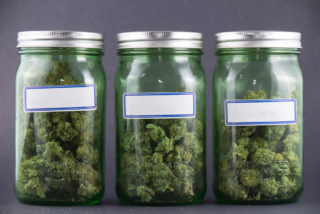We’ve written extensively about the dos and don’ts of filing cannabis-related state and federal trademarks, and we all know by now that you cannot obtain a federal trademark registration for goods or services that are not lawful pursuant to federal law. But I’ve heard a lot of creative arguments in this space, and have had many clients indicate an interest in challenging the status quo at the United States Patent and Trademark Office (USPTO).
Unfortunately (or fortunately, depending on how you look at it), the Trademark Trial and Appeals Board (TTAB) has handed down numerous opinions of precedent that lay forth the USPTO’s position on the “lawful use in commerce” requirement in detail. In this post, I thought it would be useful to breakdown the TTAB’s analysis on this issue via their In re PharmaCann LLC opinion, which was issued in June of 2017.

In the PharmaCann case, the Applicant sought registration of two trademarks: PHARMACANN and PHARMACANNIS, both for “retail store services featuring medical marijuana,” in International Class 35, and “dispensing of pharmaceuticals featuring medical marijuana,” in International Class 44. The Examining Attorney refused registration of both marks pursuant to Sections 1 and 45 of the Trademark Act, 15 U.S.C. §§ 1051 and 1127, on the ground that Applicant could not allege a bona fide intent to make lawful use of the marks in commerce because the services identified involved the distribution and dispensing of cannabis, which is a controlled substance whose distribution and dispensing are illegal under the federal Controlled Substances Act (CSA), 21 U.S.C. §§ 801 et seq..
In its opinion, the TTAB pointed out that it has “consistently held that, to qualify for a federal … registration, the use of a mark in commerce must be ‘lawful’.” In re JJ206, LLC, 120 USPQ2d 1568, 1569 (TTAB 2016) (affirming refusal to register POWERED BY JUJU and JUJU JOINTS for cannabis vaporizing and delivery services for lack of lawful use in commerce). The TTAB further elaborated that for a mark to be eligible for federal registration, “any goods or services for which the mark is used must not be illegal under federal law.” In re Brown, 119 USPQ2d 1350, 1351 (TTAB 2016). And even if an Applicant files on an intent-to-use basis (meaning they intend to use the mark in commerce in the near future but have not done so yet), if the identified goods or services with which the mark is intended to be used are illegal under federal law, “the applicant cannot use its mark in lawful commerce, as it is a legal impossibility for the applicant to have the requisite bona fide intent to use the mark.” JJ206, 120 USPQ2d at 1569.
In general, registration will not be refused for lack of lawful use in commerce unless either “(1) a violation of federal law is indicated by the application or other evidence …, or (2) when the applicant’s application-related activities involve a per se violation of a federal law.” Brown, 119 USPQ2d at 1351. In the case at hand, the TTAB deemed the Applicant’s marijuana distribution and dispensing activities to be a per se violation of the CSA. The analysis here was pretty straightforward, where the CSA prohibits, among other things, manufacturing, distributing, or dispensing controlled substances (21 U.S.C. § 841(a)(1)), and where marijuana is a Schedule I controlled substance under the CSA. 21 U.S.C. § 812(c) Schedule I (c)(10).
The Applicant here made two arguments in opposition to the TTAB’s position. The first argument was that “[s]ince 2009 the Department of Justice has consistently refused to treat medical marijuana as an illegal drug by consistently refusing to enforce the Controlled Substances Act against it.” In making its argument regarding the federal government’s lack of enforcement against medical marijuana businesses operating in compliance with state law, the Applicant relied on the (now rescinded) Cole Memorandum. But the TTAB clarified that it had previously decided in JJ206 that the Cole Memorandum “provides no support for the registration of a trademark used on goods whose sale is illegal under federal law,” and that this determination applied with equal force to the Applicant in this case’s intended use of its marks for distributing and dispensing medical marijuana.
The Applicant’s second, and more novel, argument was that “Congress has taken the same position as the Department of Justice,” because in the Consolidated and Further Continuing Appropriations Act of 2015 (as renewed in the Consolidated Appropriations Act of 2016, subsequent continuing resolutions, and in the Consolidated Appropriations Act of 2017), Congress has prohibited the Department of Justice from utilizing funds to prevent states that have legalized medical marijuana from implementing their own state laws authorizing the use, distribution, possession, or cultivation of medical marijuana. The Applicant’s argument was that Congress’ decision not to fund the DOJ to enforce the CSA against medical marijuana, “it would make no sense and serve no purpose for the Board to take a different position…”.
The TTAB, however, found this second argument equally lacking, and relied on United States v. McIntosh (833 F.3d 1163, 1169-70 (9th Cir. 2016)) for its analysis. In that case, the court concluded that the Appropriations Acts and the Rohrabacher-Farr Amendment did not make medical marijuana legal under the CSA. The TTAB applied that conclusion to the case at hand and rejected the Applicant’s argument.
These TTAB opinions are instructive in that they give us a clear view into how the USPTO is lawful use in commerce requirement; although the legal status of cannabis and particularly the federal government’s enforcement efforts remain murky, so long as marijuana remains a Schedule I controlled substance, federal trademark protection will not be available.
For other posts on cannabis trademarks, check out the following:
- Revisiting the Basics of Federal Trademarks in the Cannabis Industry
- Yet ANOTHER Cannabis Trademark Infringement Case: Tapatio Foods Files Suit
- What NOT to do with your Cannabis Brand: The Gorilla Glue Trademark Infringement Dispute
- Another Cannabis Trademark Application Bites the Dust
- Cannabis Trademarks: The Importance of Monitoring Your Brand























